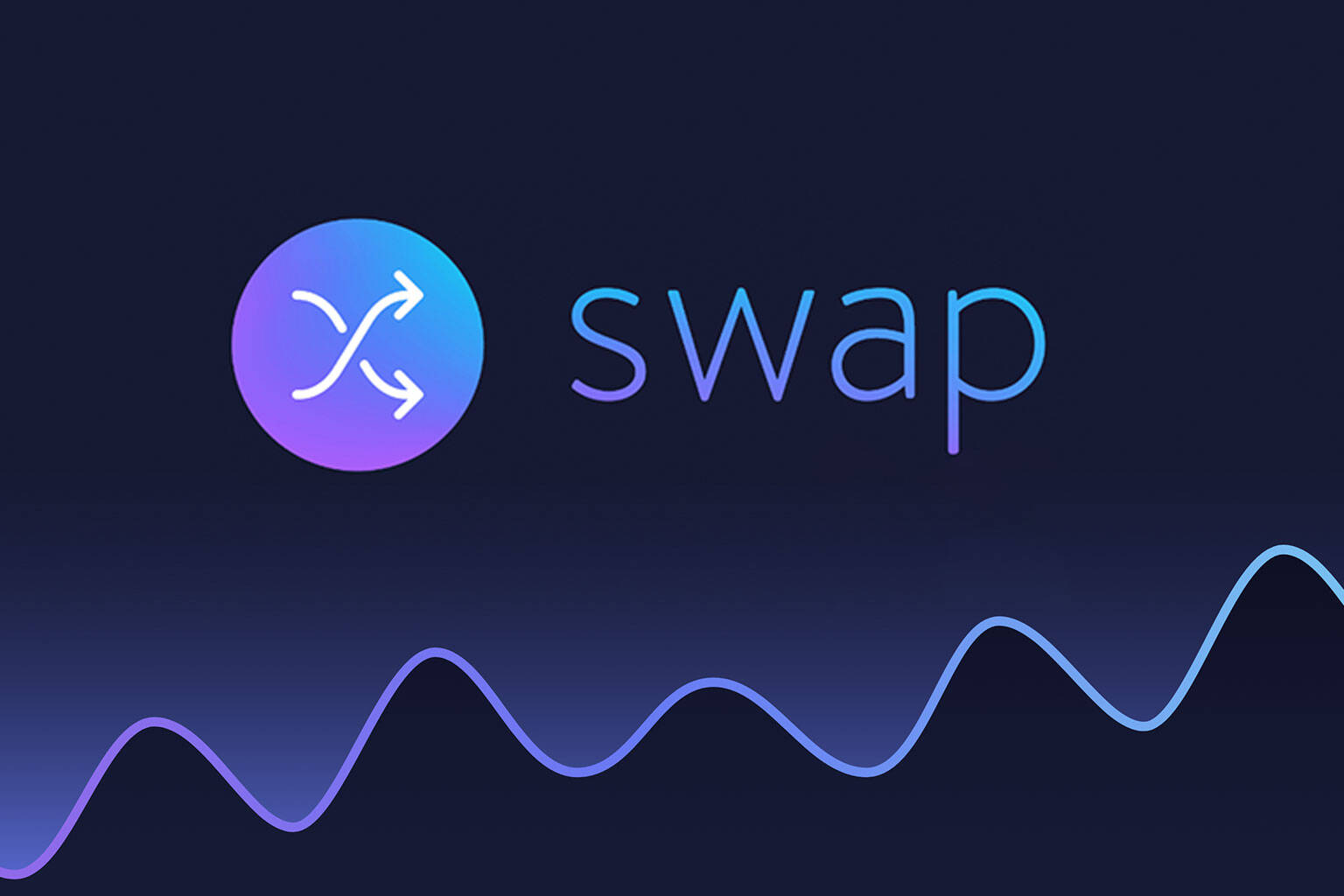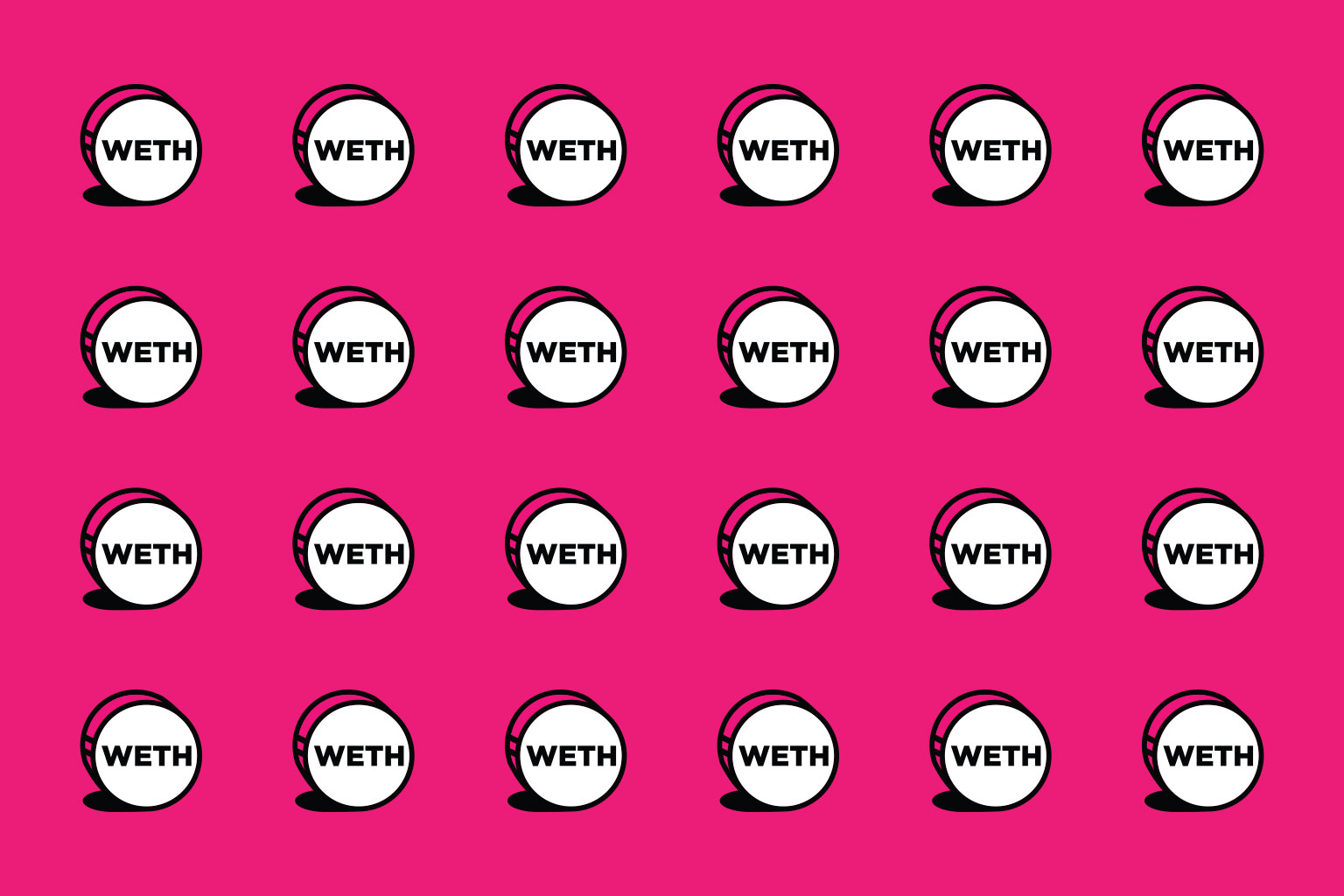Cryptocurrency trading: what is it?
Cryptocurrency trading refers to buying and selling cryptocurrencies through a contract for difference (CFD) trading account or on an exchange. CFD trading lets you speculate on the price movements of cryptocurrencies like Bitcoin (BTC) without owning the underlying assets. You can take a long position (buy) if you believe the value of a cryptocurrency will increase or a short position (sell) if you believe it will decrease. These are leveraged instruments, meaning that you only need to put down a small deposit (called a margin) to have exposure to the market’s total value. However, leveraged trading also magnifies your potential profits and losses.
Cryptocurrency options are another financial instrument that derives its value from the price of an underlying asset, in this case, a cryptocurrency. Investors can use options to reduce risk or increase market exposure.
It is essential for anyone considering cryptocurrency trading to have a thorough understanding of the assets and technologies involved, including the foundational cryptocurrency, Bitcoin.
Trading cryptocurrency, like other financial markets, can be complex and requires knowledge of various components. Bitcoin was the first cryptocurrency launched in 2009 and remains the largest and most well-known. However, the cryptocurrency industry has grown significantly since then, with many other digital assets, known as altcoins, becoming tradable for profit. The largest altcoin is Ether (ETH).
This guide will provide an overview of cryptocurrency trading strategies and introduce you to the various platforms and applications available for trading. It will also cover the components of trade, different trading styles, and the role of technical and fundamental analysis in creating a comprehensive trading strategy. By the end of this guide, you should have a better understanding of how to trade cryptocurrency and create a successful trading strategy.
Trading cryptocurrency for beginners
Many different approaches exist in terms of how to trade cryptocurrencies. To start trading cryptocurrencies, one first needs adequate knowledge of the subject. It is also critical to know the associated risks and the laws that may apply based on one’s jurisdiction, and decisions should be made accordingly.
- Sign up for a cryptocurrency exchange such as Coinbase, Kucoin, or Binance.
- Provide personal identifying information, including address, date of birth, Social Security number, and email address, to complete Know Your Customer (KYC) requirements.
- Connect your bank account to fund your account. This can be done through debit cards or wire transfers.
- Choose a cryptocurrency to invest in. Popular choices include Bitcoin and Ether, but you can also consider smaller altcoins with higher upside potential.
- Consider using a crypto trading bot like RobotaLife or implementing a trading strategy through automatic crypto trading software like Coinrule.
- If actively trading, keep your funds on the exchange for easy access. If holding cryptocurrency long-term, consider purchasing a software or hardware wallet for added security.
Basics of Crypto trading
The value of Bitcoin is constantly changing due to its open market, with fluctuations occurring every second and day. As a decentralized digital asset, Bitcoin is subject to unique challenges around volatility that other currencies do not experience.
It is essential for those new to Bitcoin trading to have a basic understanding of how the crypto-asset market works to safely navigate the market and get the most value from their participation in the cryptocurrency economy. Trading can range from a simple transaction, such as exchanging Bitcoin for a fiat currency like the US dollar, to more complex strategies involving various trading pairs to grow an investment portfolio. However, as the size and complexity of a trade increase, so does the risk exposure.
Below are some basic concepts to consider when trading Bitcoin.
In a cryptocurrency trade, there is a buyer and a seller. Trade involves the exchange of an asset at a specific price, which determines the asset’s market value. Generally, buyers tend to set their orders at lower prices than sellers, which creates two sides of an order book.
When there are more buy orders than sell orders, the asset price tends to increase due to higher demand. Conversely, the price tends to decrease when there are more sell orders than buy orders. In trading, it is common to follow the adage “buy low, sell high,” meaning to try to purchase an asset at a low price and sell it at a high price for a profit.
However, there is also the option to go long or short on an asset. Going long on an asset means buying it and hoping for its price to go up, while going short on an asset means selling it to repurchase it when its price falls, profiting from the price drop. Shorting involves selling borrowed assets that are paid back later, and it can be more complex than simply buying and selling. Understanding the basic dynamics of the cryptocurrency market can help traders make informed decisions and potentially minimize loss and maximize gain.
Style of trading
There are many different trading styles, and the appropriate style for a particular trader will depend on their goals, risk tolerance, and the market conditions they are operating. Some common styles of trading include:
Day trading: This involves buying and selling assets within the same day and typically involves a high level of activity and rapid decision-making. Day traders aim to take advantage of short-term price fluctuations and often use technical analysis to inform their trades.
Swing trading involves holding assets for extended periods, typically several days to a few weeks. Swing traders aim to profit from medium-term price movements and may use technical and fundamental analysis to inform their trades.
Position trading involves holding assets for extended periods, typically several weeks to months. Position traders focus on longer-term trends and may use fundamental analysis to inform their trades.
Scalping: This involves taking advantage of small price fluctuations, typically a few seconds to a few minutes, over a brief period. Scalpers aim to profit from small movements in the market and often use high leverage to amplify their returns.
It’s important to note that different trading styles come with different levels of risk and reward. Traders should consider their own goals and risk tolerance before choosing a trading style.
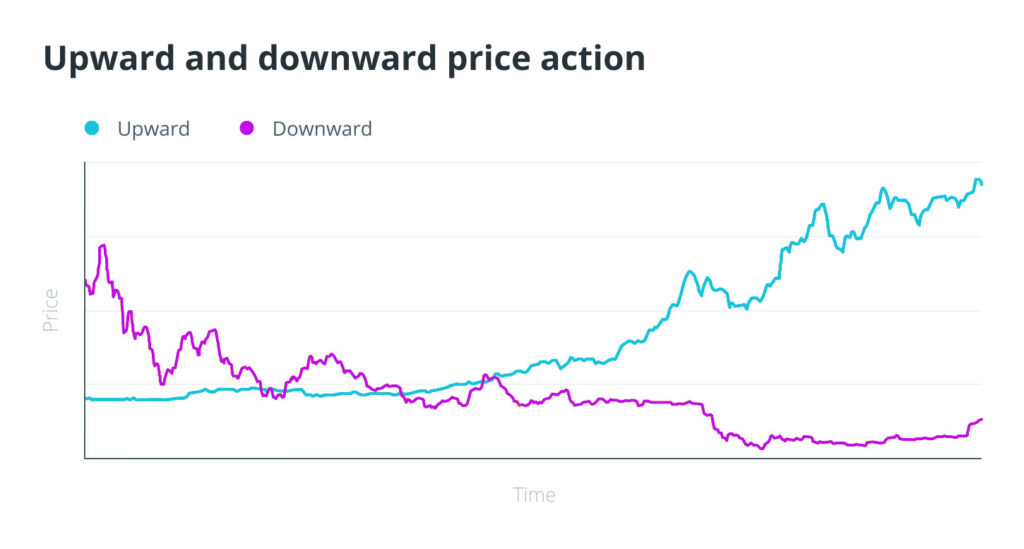
Trading in the cryptocurrency market is essentially just people buying and selling assets. The market comprises all the active buy and sells orders at any given time, and analyzing the market involves looking for patterns or trends over time. There are two main market trends: bullish when prices are increasing and bearish when prices decrease. These trends can also exist within larger trends, depending on the time frame being considered. Consolidation, or a period of sideways or range-bound price movement, can occur after a sharp trend, when demand is low, and when trading volumes are low. Understanding these essential market dynamics can help traders decide when to buy or sell assets.
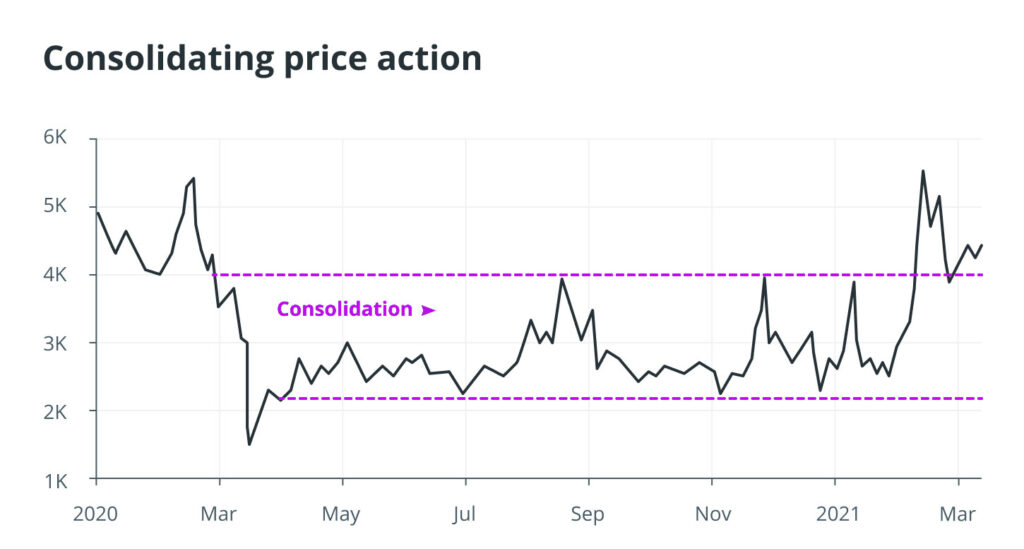
Technical analysis
Technical analysis (TA) is used to evaluate market data, such as price and volume, to predict future price movements. There are many different TA indicators that traders can use to analyze the market, ranging from simple to complex. This article will discuss some essential tools that can be used at the macro and micro levels.
Using Technical Analysis to Navigate the Ever-Changing Market
Traders can use technical analysis to identify patterns in the market over different time frames, including hours, days, months, and even years. An underlying market structure leads to certain behaviors, which can be divided into four main phases: accumulation, markup, distribution, and decline. As the market moves through these phases, traders may adjust their positions by consolidating, retracing, or correcting as needed. A trader needs to understand the current market dynamics, including whether the market is dominated by bulls or bears, to make informed decisions using technical analysis. Technical analysis is crucial for positioning oneself in the constantly changing market and navigating fluctuations.
Understanding the Role of Whales in Cryptocurrency Trading
Price movements in financial markets are often influenced by large traders, known as “whales,” who have significant funds available to trade. These whales can act as “market makers,” placing bids and offers on both sides of the market to create liquidity for an asset while making a profit. Whales can be found in various markets, including stocks, commodities, and cryptocurrencies. Traders need to understand the tactics and tools favored by whales, such as technical analysis indicators, as they tend to be experienced and skilled traders. By anticipating the actions of whales, traders can potentially profit by aligning their strategies with the moves of these expert market participants.
Emotional Factors in Cryptocurrency Trading
It is important to remember that real people, subject to emotional behaviors, are behind most trades in the financial market. The “Psychology of a Market Cycle” chart illustrates the emotional rollercoaster that traders can experience:
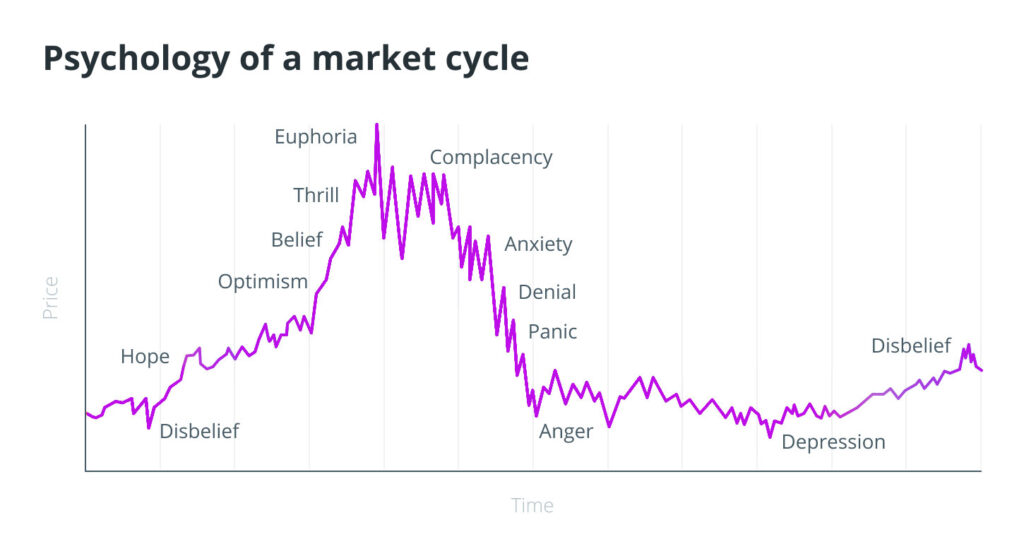
While the bull/bear framework helps understand market trends, the psychological cycle above provides a more detailed view of market sentiment. One of the basic principles of trading is to leave emotions out of decision-making, but it can be difficult to avoid the influence of group mentality. The rally from hope to euphoria is often driven by fear of missing out (FOMO) from those who have not yet entered the market.
Navigating the valley between euphoria and complacency is crucial for timing an exit before the bears take over and traders panic sell. It is essential to consider high-volume price action, which can indicate the general momentum of the market when making decisions in this phase. The “buy low” philosophy is evident that the best time to accumulate in the market cycle is during the depression following a steep drop in price. The higher the risk, the higher the potential reward.
Traders should be aware of the emotional factors that can impact their strategies, such as the influence of media, chat rooms, and so-called experts. These markets can also be vulnerable to manipulation by whales and other large traders who can affect market sentiment. Doing thorough research and making decisive trades in the cryptocurrency market is essential.
Essential tools
Support and resistance
Support and resistance are essential technical analysis (TA) indicators that reflect the price levels at which an asset is likely to find support (a level where it is more likely to rise) or resistance (a level where it is more likely to fall). These barriers tend to form in the market, preventing the price action from going too far in a particular direction.
Support is the price level where a downward trend tends to pause due to an influx of demand. When prices decrease, traders buy low, creating a support line. Conversely, resistance is the price level where an upward trend pauses due to a sell-off. Many cryptocurrency traders use support and resistance levels to predict the direction of the price and make informed trading decisions. They may adapt their strategy as the price breaks through its upper or lower bounds. Once traders identify the floor and ceiling, this provides a zone of activity in which they can enter or exit positions. Buying at the floor and selling at the ceiling is a common strategy.
If the price surpasses these barriers in either direction, it can indicate the market’s overall sentiment. This is an ongoing process, as new support and resistance levels tend to form when the trend breaks. Understanding and identifying support and resistance levels can be helpful tools for traders in the cryptocurrency market.
Trendlines
Support and resistance levels are important indicators used by traders to identify potential trends in the market, including the cryptocurrency market. These levels reflect the price at which an asset is likely to find support (a level where it is more likely to rise) or resistance (a level where it is more likely to fall). While traders commonly use static support and resistance levels, the price action tends to trend higher or lower over time, with these barriers shifting accordingly. A sequence of support and resistance levels can indicate a larger trend in the market, which a trendline can represent.
When the market is upward, resistance levels begin to form, and the price action slows as it is pulled back toward the trendline. Traders pay close attention to the support levels of an ascending trendline, as they can help prevent the price from dropping significantly lower. In a downward-trending market, traders will watch for the sequence of declining peaks and connect them to a trendline. The strength of any support or resistance levels and their resulting trendlines increases as they reoccur over time, so traders often record these barriers to inform their ongoing trading strategy.
Chart patterns
Candlestick charts are a popular way for traders to visualize and analyze price action in financial markets, including cryptocurrency. These charts depict the open, close, high, and low prices for a given period, and the comprehensive portion of the candlestick represents the price at which the asset opened or closed, depending on its color. The lines above and below the comprehensive portion, known as the wicks, represent the range of prices at which the asset was traded during that period. Candlestick charts can be used to analyze different time frames, from one minute to one day or longer, and can reveal different patterns depending on the chosen time frame. Traders often use candlestick charts to anticipate trends and make informed trading decisions based on the emotions and sentiments of the market.
Round numbers
Support and resistance levels are important indicators in financial markets, including cryptocurrency. These levels reflect the price at which a particular asset is likely to find support (a level where it is more likely to rise) or resistance (a level where it is more likely to fall). One factor influencing support and resistance levels is inexperienced or institutional investors’ fixation on round-number price levels. For example, in the case of Bitcoin, it is common for the price to have difficulty surpassing specific points evenly divisible by $10,000, as many trades tend to cluster around these round-number levels. This can create resistance and make it difficult for the price to rise above these levels.
This tendency towards fixation on round-number price levels can be attributed to the emotional nature of human traders and their tendency to rely on shortcuts when making decisions. When a specific price point is reached, it can often generate excitement and anticipation in the market, resulting in increased market activity. Overall, understanding the influence of support and resistance levels is essential to successful trading in the cryptocurrency market.
Moving averages
Traders often use moving averages to visualize and analyze a financial market’s support and resistance levels, including the cryptocurrency market. A moving average is a single visual line representing a data set’s average value over a certain period. It is created by smoothing out the market data of support and resistance levels and trendlines, and it can be used to trace the bottom support levels of an upward trend and the peaks of resistance during a downward trend. When analyzed in conjunction with trading volume, the moving average can serve as a valuable indicator of short-term momentum in the market. Moving averages are a popular tool among traders for identifying trends and making informed trading decisions.
Fundamental analysis
Fundamental analysis is a method of evaluating the intrinsic value of an asset, such as a cryptocurrency, by analyzing its underlying economic, financial, and other fundamental factors. This approach to analysis seeks to understand the underlying drivers of value, including the asset’s market demand, its competitive landscape, and the economic conditions in which it operates.
Some common fundamental factors that may be analyzed when evaluating a cryptocurrency include:
Market demand: This includes the current and potential demand for the cryptocurrency and any factors that may affect its demand in the future.
Competitive landscape: This includes an analysis of the cryptocurrency’s competition, including the strengths and weaknesses of its competitors and the overall market dynamics.
Economic conditions: This includes an analysis of the economic conditions in which the cryptocurrency operates, including macroeconomic trends and the overall state of the economy.
Financial factors: This includes an analysis of the cryptocurrency’s financial statements, including its revenue, expenses, and profitability.
Fundamental analysis can be a valuable tool for investors looking to understand the long-term value of a cryptocurrency and make informed investment decisions.
Crypto trading vs. Stock trading
Crypto trading and stock trading are both methods of buying and selling financial assets in the hopes of making a profit. However, there are several key differences between the two:
Asset type: Crypto trading involves buying and selling cryptocurrencies, while stock trading involves buying and selling stocks in publicly traded companies.
Market structure: The cryptocurrency market is decentralized and largely unregulated, while the stock market is centralized and regulated by organizations such as the Securities and Exchange Commission (SEC).
Volatility: Cryptocurrencies are known for their high volatility, with prices often fluctuating significantly quickly. In contrast, stock prices tend to be more stable, although they can still experience significant price movements.
Market hours: The cryptocurrency market operates 24/7, while the stock market operates during specific hours of the day.
Trading fees: Crypto exchanges often charge trading fees, while stock trading may involve additional brokerage fees or commissions.
Both crypto trading and stock trading can be potentially lucrative, but they come with different risks and rewards. It is essential for investors to understand the differences between the two and to carefully consider their investment goals and risk tolerance before deciding which type of trading is right for them.
Trading cryptocurrency can be risky, as the market is highly volatile, and prices can fluctuate significantly in a short period. Any physical asset or government does not back cryptocurrencies, and their value is primarily based on market demand and investor sentiment. This makes them more susceptible to market and price manipulation, which can increase the risk for traders.
In addition, the cryptocurrency market is decentralized and largely unregulated, making it more difficult for investors to protect their assets and seek recourse if something goes wrong. There have been hacks and scams in the cryptocurrency market, which can result in the loss of invested funds.
It is essential for traders to be aware of these risks and to carefully consider their investment goals and risk tolerance before deciding to trade cryptocurrency. It is also essential to do thorough research and due diligence on the cryptocurrency and the exchange platform being used and to use secure storage methods to protect assets. Trading cryptocurrency can be potentially lucrative, but it is essential to approach it with caution and carefully manage risk.
Be the first to try
Join our mailing list for early access to our service
Related Posts
February 14, 2023
Safesun coin

February 12, 2023
$loomi to USDT

February 8, 2023
XWP Price
